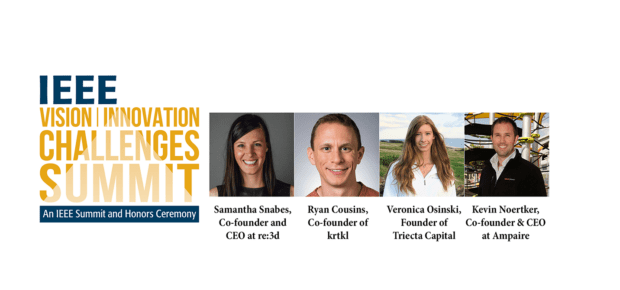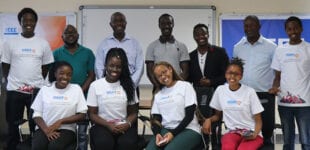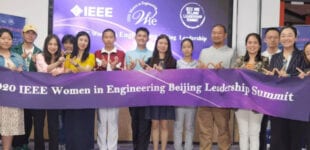April 11, 2018
Four talented entrepreneurs and investors have seized opportunities, solved problems, and continued to bring forth ideas that benefit society. Here they share their views and insights on the start-up community, approaching everyday challenges, and what keeps them going.
Samantha Snabes, Co-founder and CEO at re:3d
re:3d is unlocking new applications and growth markets worldwide in 3D printing. Gigabot, re:3D’s flagship technology, enables industrial-strength 3D printing of objects 30x larger than than competing desktop models. re:3d recently won one million dollars from WeWork for their technology.
Ryan Cousins, Co-founder of krtkl
Krtkl was founded in 2014 and the team’s obsession with quality, functionality, and the user experience shows in every element of its designs. The company mantra: Create something different.
Veronica Osinski, Founder of Triecta Capital
Trifecta Capital – venture capital firm – partners with startups starting at the seed stage and across industries with an initial $125k-$250k investment. They believe the best founders are mission-driven.
Kevin Noertker, Co-founder & CEO at Ampaire
Ampaire’s company mission is to provide the world with all-electric-powered commercial flights that are affordable, quiet, and environmentally conscious.
What inspires you to keep going in the face of challenges?
Samantha: At re: 3D we prefer to view challenges as opportunities. With this perspective, new problems are exciting and invite creative problem-solving.
Tell us how you came up with the idea for your company?
Ryan: We were previously involved in embedded systems consulting work for companies building mechatronic products for applications like medical devices, industrial automation, and consumer electronics. Despite the significant architectural overlaps across these products and applications, we found we were solving the same problem over and over again, with neither us, nor our customers, being able to take advantage of past projects and developments. In addition, we realized there were no compelling development platforms that were a) practical for professional/commercial use, b) easy to get working “out of the box,” or c) reasonably affordable. Out of this experience, snickerdoodle was born: a professional-caliber, compact, affordable, and thoughtfully integrated platform that was easy to get started on, was flexible enough to adapt to a variety of applications without being overly complicated, and was equally practical for one-off development projects/R&D as it was for wide commercial deployment. The name “krtkl” (pronounced “critical”) is rooted in our focus on high-reliability, safety-critical/mission-critical hardware, software, systems, and standards … with a bit of “techie”/creative flair.
Tell us how you came up with the idea for your company?
Kevin: Ampaire’s cofounder and CTO, Cory Combs, has been watching the progress on Electric Vehicle technology for almost a decade, assessing when it would be ready to be brought to aviation. In 2015 he realized it was just on the edge of being viable. He pulled our founding team together and we kicked off Ampaire in early 2016 with a vision for fully electric air travel.
What has been your most rewarding experience?
Kevin: It has been inspiring and rewarding to meet and present alongside so many amazing entrepreneurs and visionaries. Especially rewarding was when Ampaire received the Top Aerospace Startup award at the 2017 Hello Tomorrow Global Deep Tech Challenge in Paris, France. In the not-too-distant future, the most rewarding experience will likely be when we fly our first full-sized electric plane.
Ryan: Despite all the challenges along the way, the experience of bringing snickerdoodle to market has been extremely rewarding. We launched snickerdoodle as part of a crowdfunding campaign in late 2015, and while there were undoubtedly more doubters than believers, the amount of support we’ve received from the development community has been overwhelming—people who wholeheartedly believe in both the product and the mission. We’ve seen some pretty dark days—many from which we weren’t entirely sure how or if we were going to emerge—but the encouragement and willingness to help are affirmations that it’s worth forging ahead. We’ve also had a couple of commercial customers with some really interesting applications successfully make it to market with snickerdoodle-based products, which has been great. A lot of the time, starting and operating a business (especially one involving the development and manufacturing of ”deep tech” hardware) is totally overwhelming, and it’s easy to get caught up with and discouraged by the everyday struggle, but every now and then you have to take a step back and acknowledge how far you’ve come and remind yourself to savor the journey because there’s still so much further to go.
Did you always know you wanted to be an investor?
Veronica: While I was in college, I was a finance major and taught corporate finance and researched conflict of interest/poor corporate governance that led to the financial crash in 2008. I didn’t even know what venture capital was back then, and being “an investor” was not a motivation at all. I was interested in new forms of finance like microfinance and the impact it could have on bringing financial inclusivity and development to the world. After college I spent a summer in South Africa setting up a dairy business in a rural village. That decision was driven predominantly around deducing that I could have the biggest positive impact by being an entrepreneur in the developing world. In most parts of Africa, you are still addressing bottom of the pyramid needs, rather than top of the pyramid needs.
After that experience, I was introduced via my network to Mark Stevens, a former managing partner from Sequoia Capital, and joined the world of venture capital working with him at S-Cubed Capital. I apprenticed at S-Cubed, where I learned the ropes of financing and partnering with startups for the long term. It was both overwhelming and exciting. I served as a board observer for 4 companies in the portfolio where I was able to see different phases of company building from seed to post Series C. I also sourced and worked on investments in seed stage startups, including Embark (acq. APPL), Second Spectrum, and Secret.
Apprenticing at S-Cubed led me in 2014 to become a founder of Trifecta Capital, a seed stage fund based in San Francisco. I started Trifecta because of two theses on venture investing that were not widespread at the time. The first was that diversity in venture capital was a competitive advantage, and Trifecta Capital as a seed stage fund managed by a woman in her 20s brought a differentiated, valuable investment perspective and a unique personal network to leverage for proprietary deal flow and for value-added relationships for portfolio companies.
The second reason was a thesis that the best founders in the world are mission driven. Bill Gates of Microsoft, Mark Benioff of Salesforce, Mike Cannon-Brookes of Atlassian—just to name a few—massively care about mission. I want to back these sorts of generation-defining founders and so aligned the fund in a way that was also mission driven. I allocate 20% of the carry or profits of Trifecta Capital on each investment check to a philanthropy of the entrepreneur’s choice. It’s a twist on the Founders Pledge, and I’m incredibly proud to back exceptional founders where this philanthropic component resonates.
If you could go back and do it again, what would you change or do differently?
Samantha: If I could go back, I would have invested more energy in pursuing grants & awards from the beginning. This has proven to be an invaluable mechanism to fund R&D and scaling needs when bootstrapping that we could have benefited from a couple of years ago.
Ryan: There are probably more things we would have done differently than there is room on the page… but two easy and most glaring ones are: 1) it sounds obvious, but we needed to start with way more money than we thought we would need. Don’t assume you will be able to raise money after you do everything “investors” tell you is required—building a product and validating the product/business model in the market—because that is not the case. And 2) it’s questionable whether or not crowdfunding was the right approach for us/our product. If we were to go that route again, we would have gone with a much more focused launch (fewer products, simpler message, etc.), adjusted our goal and pricing to more accurately reflect what we needed/what would be practical to manufacture hardware at that scale instead of relying on the wishful thinking and irrational optimism (e.g., we’ll greatly exceed our goal, be able to get better deals with vendors and distributors, and so on). Of course, hindsight is always 20/20, but these two are ”mistakes” that have handicapped us from day one … and the last thing you want when starting a new company is to put yourself at a bigger disadvantage than the “system” already is.
Kevin: We held off on hiring a few top-notch engineers because we were concerned about our runway (amount of funding left). Once we raised our next funding round, they weren’t available anymore. If I had to do it again, I’d have leaned forward a bit and hired at least one of them on the spot.
Veronica: If I could go back, I would have wanted my younger self to have more confidence in her vision of the future. While the push for diversity among investors is in full bloom, especially with the #foundersforchange movement, back in 2014 it felt exceptionally unpopular to be selling diversity as a competitive advantage point for Trifecta Capital.
Samantha’s words of wisdom to new start-ups: “Trust your instincts. Just because you might not follow standard business principles doesn’t necessary mean you are wrong or you should try to follow someone else’s playbook for success. Don’t be afraid to fail, and pioneer a unique path that is best for your team, product, company, and community.”
Engage, learn, and hear more from these speakers at the IEEE VIC Summit at the Palace Hotel in San Francisco, California, USA. Register to attend the IEEE VIC Summit on 11 May 2018, https://bit.ly/2DLsTso





 Liquid Infrastructure: Our Planet's Most Precious Resource
Liquid Infrastructure: Our Planet's Most Precious Resource The Impact of Technology in 2025
The Impact of Technology in 2025 Quantum and AI: Safeguards or Threats to Cybersecurity?
Quantum and AI: Safeguards or Threats to Cybersecurity? Why AI Can't Live Without Us
Why AI Can't Live Without Us Bits, Bytes, Buildings and Bridges: Digital-Driven Infrastructure
Bits, Bytes, Buildings and Bridges: Digital-Driven Infrastructure Impact of Technology in 2024
Impact of Technology in 2024 Emerging AI Cybersecurity Challenges and Solutions
Emerging AI Cybersecurity Challenges and Solutions The Skies are Unlimited
The Skies are Unlimited Smart Cities 2030: How Tech is Reshaping Urbanscapes
Smart Cities 2030: How Tech is Reshaping Urbanscapes Impact of Technology 2023
Impact of Technology 2023 Cybersecurity for Life-Changing Innovations
Cybersecurity for Life-Changing Innovations Smarter Wearables Healthier Life
Smarter Wearables Healthier Life Infrastructure In Motion
Infrastructure In Motion The Impact of Tech in 2022 and Beyond
The Impact of Tech in 2022 and Beyond Cybersecurity, Technology and Protecting Our World
Cybersecurity, Technology and Protecting Our World How Technology Helps us Understand Our Health and Wellness
How Technology Helps us Understand Our Health and Wellness The Resilience of Humanity
The Resilience of Humanity Harnessing and Sustaining our Natural Resources
Harnessing and Sustaining our Natural Resources Creating Healthy Spaces Through Technology
Creating Healthy Spaces Through Technology Exceptional Infrastructure Challenges, Technology and Humanity
Exceptional Infrastructure Challenges, Technology and Humanity The Global Impact of IEEE's 802 Standards
The Global Impact of IEEE's 802 Standards Scenes of our Cyber Lives: The Security Threats and Technology Solutions Protecting Us
Scenes of our Cyber Lives: The Security Threats and Technology Solutions Protecting Us How Millennial Parents are Embracing Health and Wellness Technologies for Their Generation Alpha Kids
How Millennial Parents are Embracing Health and Wellness Technologies for Their Generation Alpha Kids Space Exploration, Technology and Our Lives
Space Exploration, Technology and Our Lives Global Innovation and the Environment
Global Innovation and the Environment How Technology, Privacy and Security are Changing Each Other (And Us)
How Technology, Privacy and Security are Changing Each Other (And Us) Find us in booth 31506, LVCC South Hall 3 and experience the Technology Moon Walk
Find us in booth 31506, LVCC South Hall 3 and experience the Technology Moon Walk Virtual and Mixed Reality
Virtual and Mixed Reality How Robots are Improving our Health
How Robots are Improving our Health IEEE Experts and the Robots They are Teaching
IEEE Experts and the Robots They are Teaching See how millennial parents around the world see AI impacting the lives of their tech-infused offspring
See how millennial parents around the world see AI impacting the lives of their tech-infused offspring Take the journey from farm to table and learn how IoT will help us reach the rising demand for food production
Take the journey from farm to table and learn how IoT will help us reach the rising demand for food production Watch technical experts discuss the latest cyber threats
Watch technical experts discuss the latest cyber threats Explore how researchers, teachers, explorers, healthcare and medical professionals use immersive technologies
Explore how researchers, teachers, explorers, healthcare and medical professionals use immersive technologies Follow the timeline to see how Generation AI will be impacted by technology
Follow the timeline to see how Generation AI will be impacted by technology Learn how your IoT data can be used by experiencing a day in a connected life
Learn how your IoT data can be used by experiencing a day in a connected life Listen to technical experts discuss the biggest security threats today
Listen to technical experts discuss the biggest security threats today See how tech has influenced and evolved with the Games
See how tech has influenced and evolved with the Games Enter our virtual home to explore the IoT (Internet of Things) technologies
Enter our virtual home to explore the IoT (Internet of Things) technologies Explore an interactive map showcasing exciting innovations in robotics
Explore an interactive map showcasing exciting innovations in robotics Interactively explore A.I. in recent Hollywood movies
Interactively explore A.I. in recent Hollywood movies Get immersed in technologies that will improve patients' lives
Get immersed in technologies that will improve patients' lives